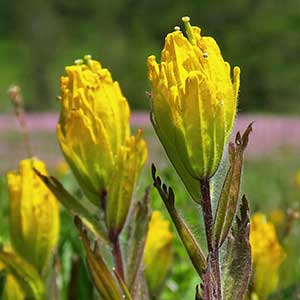Castilleja levisecta
Castilleja christii
golden Indian paintbrush, golden paintbrush
Christ's Indian paintbrush, John Christ's paintbrush
few to many, erect, ± decumbent or creeping at base, unbranched, sometimes branched, hairs spreading, medium length and long, soft, mixed with short stipitate-glandular ones.
several, erect to ascending, unbranched, sometimes branched, glabrous or hairs spreading, short and long, ± stiff, sometimes stipitate-glandular especially distally.
green to purple or brown-tinged, linear-lanceolate proximally, oblong-ovate or -obovate distally, 0.8–5.2 cm, not fleshy, margins plane, distalmost sometimes ± wavy, involute, 3–7(–11)-lobed, apex obtuse;
lobes erect to ascending, linear to linear-spatulate, very short, toothlike, usually arising from distal 1/3 of blade, apex rounded.
green, narrowly to broadly lanceolate, (1–)2–5(–6) cm, not fleshy, margins plane, flat or involute, (0–)3(–5)-lobed, apex acute to rounded;
lobes erect or ascending, linear, lanceolate, or triangular, sometimes very small, apex acute to rounded.
2.5–25 × 1–4 cm;
bracts bright yellow throughout, or proximally greenish, distally bright yellow, sometimes deep yellow-orange, especially with age, oblong, elliptic, or obtuse to ovate, (0–)5–9(–13)-lobed, sometimes wavy-margined;
lobes erect to ascending, oblong, short to medium length, arising above mid length, central lobe apex rounded, lateral ones rounded to acute.
3–6 × 2–4 cm;
bracts proximally greenish, distally pale orange or pale yellow, sometimes red-orange, lanceolate or narrowly elliptic to ovate, sometimes obovate, 3–5-lobed;
lobes ascending, linear, medium length to long, arising at or below mid length, apex acute to obtuse.
straight or slightly curved, 17–28 mm;
tube 12–15 mm;
beak exserted, adaxially green or greenish yellow, 6–8 mm;
abaxial lip yellow or greenish, reduced, not inflated, 2–3 mm, 25–33(–50)% as long as beak;
teeth ascending to erect, yellow, 0.5–1.5 mm.
straight, 20–30 mm;
tube 12–19 mm;
beak exserted, adaxially green, 7–12 mm;
abaxial lip green, reduced, included or visible through cleft, 1.5–2 mm, 10–20% as long as beak;
teeth incurved, deep green, 1.5 mm.
distally yellow, 13–22 mm;
abaxial and adaxial clefts 4–9.5 mm, 30–40% of calyx length, deeper than laterals, lateral 2.5–4.5 mm, ca. 25% of calyx length;
lobes linear to narrowly oblong or narrowly lanceolate, apex obtuse, sometimes rounded to acute.
colored as bracts, 17–22(–24) mm;
abaxial clefts 9–12(–13) mm, adaxial 7–11 mm, clefts 50% of calyx length, deeper than laterals, lateral 2–6.5(–8.5) mm, 20–50% of calyx length;
lobes lanceolate to narrowly lanceolate, apex acute to obtuse.
= 24.
Castilleja levisecta
Castilleja christii
Castilleja levisecta is listed as threatened in the United States and endangered in Canada, where it is extremely rare. Most of its grassland habitat has been altered by development in the Puget Trough, and there are historical stations in the metro areas of what are now Victoria, Portland, and Seattle. For several decades, C. levisecta was considered extirpated from Oregon. However, recent reintroduction programs in Oregon and Washington have been very successful at reestablishing this species at several sites in the Willamette Valley. The bright yellow inflorescences often gradually age to a golden yellow color, unique in the genus.
Castilleja levisecta is in the Center for Plant Conservation’s National Collection of Endangered Plants.
(Discussion copyrighted by Flora of North America; reprinted with permission.)
Castilleja christii is endemic to subalpine meadows near the summit of Mt. Harrison in the Albion Mountains, Cassia County. Morphologically, it most closely resembles the widespread C. hispida var. acuta, but a recent molecular study (D. L. Clay et al. 2012) presents clear evidence for a homoploid hybrid origin for the species, incorporating portions of the genomes of C. linariifolia and C. miniata. This is the first documented case of homoploid origin in Castilleja.
Castilleja christii is in the Center for Plant Conservation’s National Collection of Endangered Plants.
(Discussion copyrighted by Flora of North America; reprinted with permission.)


